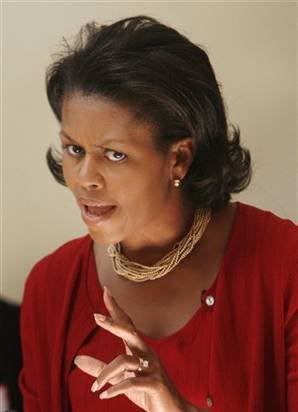

 There are a lot of female players involved in politics in this day and age. In the primaries there was Hillary Clinton, next to our now president-elect is Michelle Obama, and the old running mate of John McCain was Sarah Palin. These three woman have played the part, but have looked it as well. Which leads me to, how should you dress as a woman in politics? To some politicians, in that arena what you wear is just as important as what you say. Supposedly, what you wear serves as an image of what you stand for and what you represent, not necessarily who you are as an individual. What does America really pay attention to though? According to a Trinity News article entitled Fashion Power, the standard woman in politics wears clothing that is more "demure, elegant, non-threatening, and certainly not individual" (McCarthy 2008). The article tries to breakdown fashion in poitics and how it translates to power. It touches on the fact that Michelle Obama faced criticism from the press for her choice in clothing. Some people considered her fashion sense to be "too fierce and too independent" all because of the color or brand name of the clothing she chooses to wear. In the Obama's campaign they talk about their homegrown working class roots yet Michelle Obama's style reflects that of a "glitzy and expensive" lifestyle (McCarthy 2008). It touches on Sarah Palin's wardrobe and how boring and safe it is because she wears dark colors and no trendy labels, pretty much nothing that will draw criticism from people. Last, but not least they bring up Hillary Clinton's sense of style. Hillary Clinton has years of experience in politics, not only as a first lady, but also as a senator of New York. Her wardrobe has been the typical standard 'female in politics' wardrobe, but all of a sudden in the primaries her dress changed. The American people started seeing her in brighter colors and aparently showing more emotion. Why did she feel the need to change her style at that particular time? The author states that there is an aparent need to dress the part, despite the loss of individual personality within politics for women.
There are a lot of female players involved in politics in this day and age. In the primaries there was Hillary Clinton, next to our now president-elect is Michelle Obama, and the old running mate of John McCain was Sarah Palin. These three woman have played the part, but have looked it as well. Which leads me to, how should you dress as a woman in politics? To some politicians, in that arena what you wear is just as important as what you say. Supposedly, what you wear serves as an image of what you stand for and what you represent, not necessarily who you are as an individual. What does America really pay attention to though? According to a Trinity News article entitled Fashion Power, the standard woman in politics wears clothing that is more "demure, elegant, non-threatening, and certainly not individual" (McCarthy 2008). The article tries to breakdown fashion in poitics and how it translates to power. It touches on the fact that Michelle Obama faced criticism from the press for her choice in clothing. Some people considered her fashion sense to be "too fierce and too independent" all because of the color or brand name of the clothing she chooses to wear. In the Obama's campaign they talk about their homegrown working class roots yet Michelle Obama's style reflects that of a "glitzy and expensive" lifestyle (McCarthy 2008). It touches on Sarah Palin's wardrobe and how boring and safe it is because she wears dark colors and no trendy labels, pretty much nothing that will draw criticism from people. Last, but not least they bring up Hillary Clinton's sense of style. Hillary Clinton has years of experience in politics, not only as a first lady, but also as a senator of New York. Her wardrobe has been the typical standard 'female in politics' wardrobe, but all of a sudden in the primaries her dress changed. The American people started seeing her in brighter colors and aparently showing more emotion. Why did she feel the need to change her style at that particular time? The author states that there is an aparent need to dress the part, despite the loss of individual personality within politics for women.My quetsion to the bloggers is:
- so are you going to pay attention to a candidate that dresses that part or has sound ideals and good leadership qualities?
- Who set the standard for female fashion in politics?
- What does wearing darker colors do for a women in politics
- What does eliminating any aspect of femininity do for a female in politics?
- There doesn't seem to be a standard for men in politics, why is this?
- Does the lack of female representatives in politics allow this 'standard' to exist in politics?
- Does the construction of this 'standard' in politics for women reflect on the oppression of women in this great nation of ours?
1. McCarthy, Ann-Maria. "Fashion Power". Trinity News. 2008. http://www.trinitynews.ie/index.php/culture/fashion/283-fashion-power
No comments:
Post a Comment